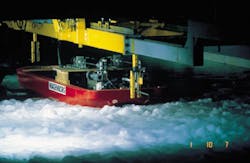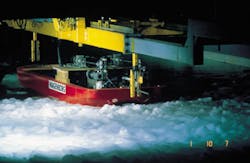Ice-breaking technology opening up E&P across Northern Russia, Caspian
Double bow improves all-conditions versatility
Vicky Wilson
Contributing Editor
Extensive model tests were carried out at Kvaerner Masa-Yard's Arctic Technology Centre to determine the final design of the two Wagenborg icebreaking supply vessels.
- The "Arcticaborg," one of two icebreaking supply vessels leaving KMY's Helsinki shipyard bound for the Caspian Sea. [45,287 bytes]
- Kvaerner Masa-Yards is developing a new seismic vessel for ice-bound regions which is being designed to lengthen the operation season and to reduce associated noise. [9,452 bytes]
The development of the hull form and the propulsion system was based on KMY's experience with building shallow draft icebreakers, together with an extended series of tests carried out at the company's Arctic Technology Centre. The tests, which used level ice, ice ridges and rubble fields, concluded that, by utilizing KMY's new double acting hull technique, the vessels would have some 20% higher performance than comparative vessels.
Following the development stage, KMY won the contract to build the icebreakers which were completed in October last year. "The high level of cooperation between KMY and Wagenborg to solve problems during the concept stage was a key element in getting the work completed on time," says vice president marketing and sales, Mikko Niini. "During the extremely short construction period, this cooperation became even more important, otherwise it would not have been possible to finish the two vessels within nine months."
Caspian operations
The icebreakers reached the Caspian Sea through the Volga-Don waterway system where they have started operations to supply drilling platforms operated by OKIOC (Offshore Kazakstan International Operating Company) on a long term charter. Since the first OKIOC platform is to be installed in a water depth of less than five meters, it was necessary to build the icebreakers with a maximum draft of only 2.9 meters.The shallow draft vessels are fitted with two 1,620 kW electric azimuthing Azipod propulsion units. Built to the new "double acting" operating principle developed by KMY, the ships go stern first in heavy ice conditions and bow first in light ice conditions. In stern-first mode, the supply ships are capable of penetrating level ice of about one meter thickness and also ice ridges far thicker than the draft of the vessel which may reach the sea bottom.
In addition to cargo carrying, the supply vessels are equipped with a towing arrangement that allows them to function as assistance icebreakers, and firefighting equipment has also been installed since these are the only ships able to traffic the area during the winter months. The engine room is placed forward and there are two 1,950 kW W?rtsil? diesel engines each connected to a 2,250 kVA main generator, feeding a common power bus bar. In addition to the Azipod propulsion units, the vessels are equipped with one 150 kW bow thruster.
Arctic key market
With these deliveries and the hull of the Jotun FPSO all completed in 1998, KMY is now turning its attention to markets further afield. Using its experience gained from working in the demanding North Sea sector, Kvaerner is targeting areas such as the Pacific Rim where high value engineering relating to safety is also in demand.The Arctic region, however, is seen as a key area for the company and one in which KMY aims to be involved in all processes of development. "We are now one of the major players in this region," says Niini. "Our Arctic research facility has the largest full-scale data base of ice-going vessels as we have contact with 95% of all companies involved in ice-bound regions."
The breadth of the Kvaerner Group's expertise has proved to be relevant for projects being carried out around Sakhalin Island. Already an engineering partner with Exxon on the Sakhalin 1 project, the company is also in discussions with Marathon about developing transport solutions for the Sakhalin 2 Field, with Shell which is looking at LNG carriers for the same field and with Mobil, operator of the Sakhalin 3 project, for which KMY hopes to be awarded design engineering task contracts.
Yamal Peninsula
Another interesting area for KMY is the Yamal Peninsula. "There is a large amount of gas condensate being produced along with the gas in this area," says Niini. "At the moment, the condensate is just being flared off which means that a huge amount of potential revenue is being lost, but we are currently putting together a final report which shows that it would be economic to transport the gas condensate through the North-East Passage using our icebreaker tankers."Last winter, KMY participated in an EU funded venture to ascertain the possibility of using this route throughout the year. KMY, in partnership with Neste Shipping, provided an icebreaker tanker, the MT Uikku, which successfully transported gas condensate from Ob Bay on the Yamal Peninsula 1,000 miles to Murmansk in less than eight days.
KMY has also conducted optimization studies for transportation of oil from onshore fields in the Timon/Pechora region. "Proven reserves have already been found here but the question is how quickly the oil companies will proceed with development in the current low oil price situation," says Niini. "The problem is that the water depth around the coast is very shallow, so tankers cannot get close to the shore. An offshore terminal would have to be built 50 km away from the coast with pipelines linking the terminal to the fields."
Further west of Yamal in the Barents Sea, where the first offshore licensing round is likely to take place by the end of this year, KMY is already persuading oil companies that its' proven ice technology can overcome environmental considerations. The two Wagenborg icebreaker supply vessels for the Caspian Sea have proven to be a good reference for the company in this instance as they can demonstrate the vessels' abilities to operate continuously in shallow water, ice-bound areas.
Ongoing R&D
KMY is constantly engaged in research and development studies relating to ice technology.- One project the company currently is engaged in is to lengthen the operation season and to reduce associated noise for seismic vessels operating in ice-bound regions. So far, KMY has come up with a design for a bow-driven seismic vessel with two main thrusters that create air bubbles and help to reduce both engine noise and the sound of breaking ice. In this design, KMY has been able to achieve a wide stern clearance area through which the seismic streams are deployed and the reduction in noise levels results in a more accurate seismic survey.
- Studies are also underway for an offshore loading terminal at St Petersburg, Russia which could open up crude transportation routes to the Baltic Sea using another of KMY's icebreaking innovations, the oblique icebreaker/escort tug concept.
Copyright 1999 Oil & Gas Journal. All Rights Reserved.

